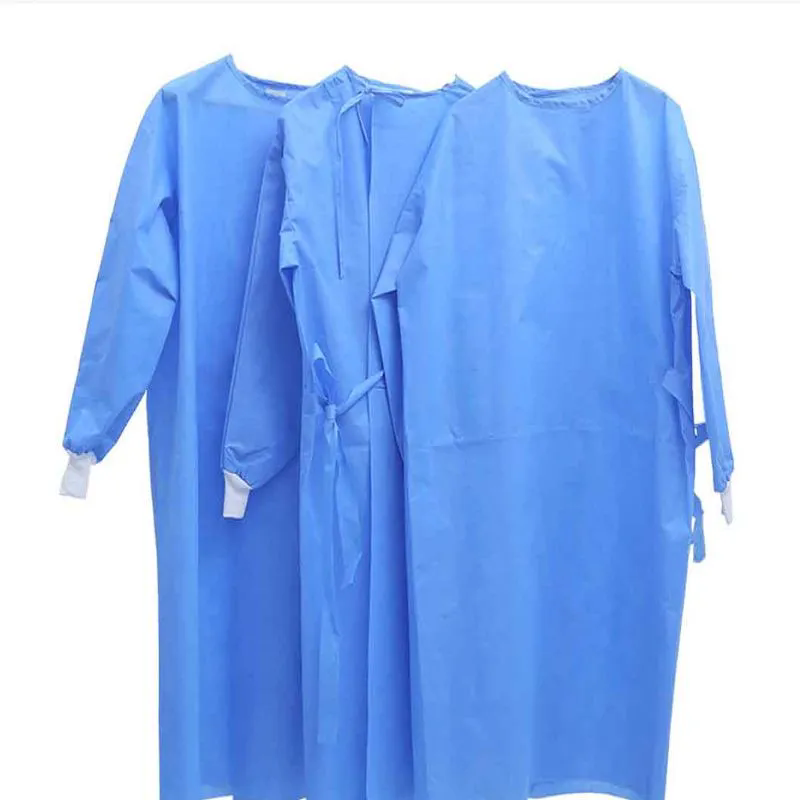Here’s an In-depth Overview of Surgical Gowns
2024-08-02
A surgical gown is a critical piece of personal protective equipment (PPE) used by medical professionals during surgical procedures to maintain a sterile environment and protect both the patient and the healthcare provider. Here’s an in-depth overview of surgical gowns:
Key Features
1. Material
- Non-Woven Fabrics: Commonly made from materials like polypropylene or polyethylene, which are designed to be fluid-resistant and provide a barrier to microorganisms.
- Sterile Fabrics: Gowns are typically sterilized before use to ensure they do not introduce any pathogens into the sterile field.
2. Design and Construction
- Full Coverage: Designed to cover the entire body from the neck to the wrists and down to the knees or ankles, depending on the design.
- Long Sleeves: Usually feature long sleeves with cuffs to prevent exposure of the wrists and arms.
- Back Closure: Often secured with ties, Velcro, or snaps at the back to ensure full coverage and ease of donning and doffing.
3. Sterility
- Pre-Sterilized: Surgical gowns are often pre-sterilized and packaged in sterile environments to maintain their sterility until use.
- Single-Use vs. Reusable: Some gowns are designed for single-use and disposed of after one procedure, while others are reusable and require proper laundering and sterilization between uses.
4. Size and Fit
- Variety of Sizes: Available in different sizes to ensure a proper fit for various body types.
- Adjustable Features: Some gowns come with adjustable ties or fasteners to provide a better fit and ensure comfort during extended procedures.
5. Protection Levels
- Fluid Resistance: Designed to resist penetration by fluids and protect against blood, bodily fluids, and other contaminants.
- Barrier Protection: Provides a barrier to microorganisms and other particles, reducing the risk of infection and contamination.
Advantages
1. Infection Control
- Prevents Contamination: Helps maintain a sterile environment by protecting both the patient and the surgical team from contamination.
- Reduces Infection Risk: Minimizes the risk of surgical site infections and cross-contamination during procedures.
2. Comfort and Functionality
- Breathable Materials: Many surgical gowns are made from breathable materials to enhance comfort for the wearer during long procedures.
- Ease of Movement: Designed to allow for ease of movement while ensuring full coverage and protection.
3. Regulatory Compliance
- Standards Compliance: Surgical gowns must meet specific regulatory standards and guidelines to ensure their effectiveness and safety, such as those set by ASTM International or the ISO standards.
Applications
1. Surgical Procedures: Used by surgeons, nurses, and other medical staff during invasive procedures to maintain sterility and prevent infection.
2. Patient Protection: May be worn during procedures that involve the patient’s exposure to potential contaminants or fluids.
3. Infection Control: Used in various healthcare settings, including operating rooms, emergency departments, and intensive care units.
Considerations
1. Appropriate Selection
- Level of Protection: Choose gowns with the appropriate level of protection based on the type of procedure and the level of risk involved.
- Comfort and Fit: Ensure the gown fits well and allows for comfortable movement, especially during long procedures.
2. Compliance with Standards
- Regulatory Standards: Ensure that the gowns meet relevant safety and performance standards, such as ASTM F2407 for surgical gowns.
3. Proper Use and Disposal
- Single-Use Gowns: Properly dispose of single-use gowns according to hospital protocols to prevent cross-contamination.
- Reusable Gowns: Follow proper laundering and sterilization procedures for reusable gowns to maintain their effectiveness and safety.
Summary
A surgical gown is an essential piece of PPE in the medical field, designed to provide a sterile barrier and protect against contamination and infection during surgical and medical procedures. By choosing the right gown based on protection levels, comfort, and compliance with standards, healthcare providers can enhance safety and ensure effective infection control in clinical settings.



